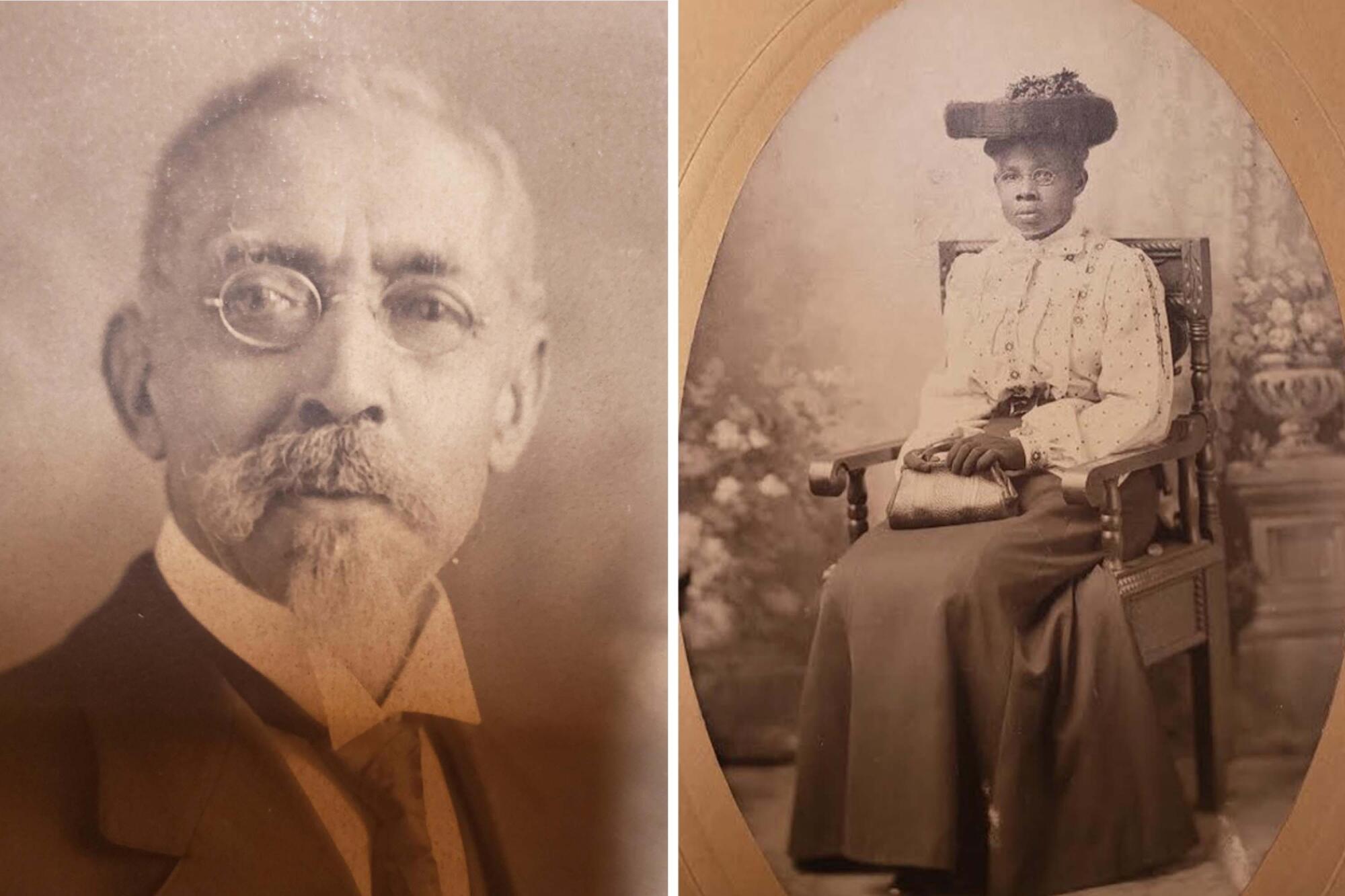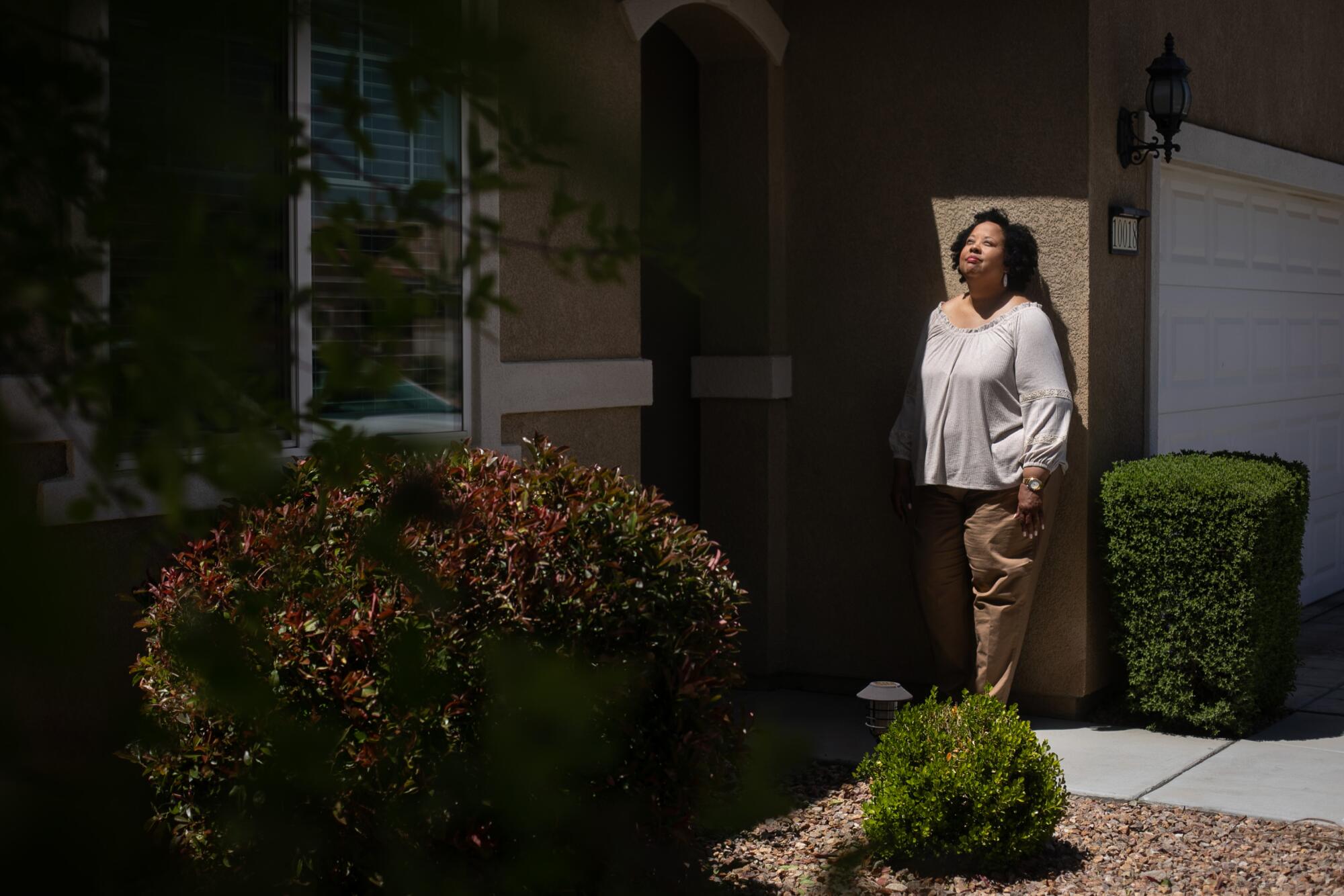
- Share via
WASHINGTON — On a rainy spring afternoon, Denise Diggs visited the Smithsonian National Museum of African American History and Culture. She was in search of a family artifact.
Wearing jeans and a blue windbreaker, she blended in with other Washington tourists, until she descended into a dimly lit exhibition area. There, Diggs began weaving in and out of visitors engrossed by the remnants of a slave ship, a wrought-iron slave collar and a six-foot statue of Thomas Jefferson standing in front of a wall of stacked bricks memorializing the hundreds of humans he owned.
Diggs was on a mission — to find a Bible once owned by her family’s patriarch.
A few steps down the hall, she discovered it, amid relics highlighting the experiences of enslaved people and the role faith played on the plantation. The 62-year-old grew teary as she stared at the Bible; it was opened to the first chapter of the Book of Exodus, which recounts the Hebrews being placed in bondage in Egypt. This was the first time she had seen the Bible on display, protected behind thick glass.
Diggs turned and noticed a tourist wearing glasses was staring at her.
“It belonged to my great-grandfather,” Diggs said, dabbing away tears as she pointed to the book.
“Oh, my goodness,” the tourist replied. “Incredible.”

“It’s pretty amazing to me, that it got here and that we still have it. And it’s legible, not destroyed [or] hard to read,” Diggs said later. “As long as people are talking about you after you pass, you never really leave.” Now that her ancestor’s Bible is on display in one of America’s most esteemed museums, she added, “it feels like he’ll live on, and our story will live on.”
The Bible’s humble journey to the Smithsonian began long before the Diggs’ family discovered it in San Bernardino more than three decades ago — in a box of books set to be donated to charity. In its pages, the family found notes from an enslaved, literate ancestor who documented five generations of births, deaths and marriages. His neat script provided the clues necessary for Diggs and her brother to trace their lineages back to the shores of Africa.
That is a rare feat for most African Americans because enslaved people were deemed property in much of the country until the end of the Civil War and emancipation. The federal government did not record their names until its 1870 census, a lack of documentation that, when coupled with other racist policies, has left empty branches on many family trees.
“It is not particularly common for African American families to find artifacts from the era of enslavement,” said Brenda Stevenson, a historian at the University of Oxford. Most enslaved people were not literate and records documenting their existence were produced by slaveholders who emphasized their financial value over their humanity, Stevenson said.

The Discovery
The Diggs family came across the Bible in the 1980s when Denise Diggs’ sister-in-law, Carlotta Diggs, discovered it while combing through a cardboard box of books earmarked for charity. The box had been sitting in an enclosed patio for years. Halfway into the pile, she found a worn and dusty Bible.
Carlotta Diggs flipped through the book and stopped cold when she came across something unusual — on a few pages, mostly those designated for family record keeping, she spotted notes detailing names and birth dates, as well as death dates and marriages.
The writing was careful and clear, mostly names and dates, sometimes dates alone:
Nov 10 1818
Kate Hunter Born in Dallas County 9th May 1843
Richard Collins Jr. Born in Dallas Co.

“[The dates weren’t] from the 1950s or ‘40s,” said Carlotta Diggs. “These were slavery dates. And it hit me that this was a book that was very, very important and that [my mother-in-law] should know about it.”
The names went on and on:
Sarah Rives March 1869
Silvay Rives 22nd July 1871
Virginia J. Collins to Morgan T. White. Aug. 24, 1892
Carlotta Diggs’ mother-in-law, Natalie Diggs, inspected the notes and recognized the names of her father and his siblings. She realized the book belonged to her grandfather Richard Collins.
Natalie “was amazed because she had no idea that that Bible had been on her patio all of that time,” said Carlotta Diggs. “And that she was this close to just getting rid of it.”
Natalie Diggs rebound the book and spent the next two decades using the Bible’s notes as a guide to build her family tree. But she hadn’t made much progress by the time she died in 2005.
Other members of the family picked up the task. They were led by Natalie Diggs’ only son, Richard, a retired captain with the San Bernardino County Sheriff’s Department. His mother, he said, had been ecstatic to have discovered the Bible. But its broader value — in filling in gaps of their story — didn’t become clear “until I started doing research,” he said.
Over the next few years, Richard Diggs, 76, sought to match family rumors with his great-grandfather’s notes. At times, he found the process of discovery frustrating.
“I heard all these stories and I chased down those rabbit holes and find out they were dead ends,” the Victorville resident said. “A lot of things we thought happened, never happened.”

His research led him to believe that Richard Collins’ grandmother lived as a free woman in Georgia before she and her daughter were kidnapped in 1818 and sold into slavery on an Alabama plantation. Collins wrote in the Bible that he was born in 1844 into slavery and that at 16 had a son out of wedlock. Diggs believes that his ancestor escaped slavery and enlisted in the Union army.
After the Confederacy fell, Collins married and reunited with his mother and grandmother in Alabama. As unchecked white supremacist violence swept through the South, Collins fled to Texas, where he had more children, accumulated some wealth and joined Freemasonry, rising to the level of Cryptic Mason. He moved in his 50s to Southern California, where he died in 1918.
“After all the research I’ve done, I know him,” said Richard Diggs. “If he walked in this room today, I would know him.”
Diggs eventually turned to modern technology and took a DNA test to learn more about his ancestry. What he found astonished him.
Whereas many African Americans are descendants of Africans who were kidnapped and sold into the slave trade before making a gory trip across the Atlantic Ocean, Diggs’ ancestors may have been indentured servants.
Nearly 13% of Diggs’ DNA hails from the Congo and Angola. The first Africans who landed in Jamestown in 1619 were indentured servants from Angola. Diggs also found out his grandfather’s surname was in the minutes of an 1813 church meeting that mentions the descendants of these former servants.

Historians said Diggs’ ability to piece together his family tree is rare.
Mary Elliot, a curator at the National Museum of African American History and Culture, said Bibles, in particular, have long been used by “Black families to record their family records, to record those important moments in their lives and to record their stories.”
But for many of their descendants, the Bibles weren’t preserved. Instead, they must rely on oral history. “There are some things that aren’t always written. They’re not always glaringly apparent,” Elliot said. “But there‘s ways to track down those breadcrumbs that tell us more about the story.”
Richard Diggs was confronted by a mystery in his research, one that also helps explain the dearth of African American records: How did Collins learn to read and write?
Literacy was very uncommon among enslaved people as it was outlawed throughout much of the South after Nat Turner’s failed rebellion in 1831, said Stevenson, the historian at the University of Oxford. By some estimates, just 10% of enslaved people were literate at the time of emancipation.
By 2012, the Diggs family had exhausted its research. That’s when Denise Diggs saw a PBS news segment about the Smithsonian Institution’s newest museum asking for African American artifacts. The family decided to donate the Bible.
Richard Diggs flew with the Bible from Los Angeles to Washington, D.C., where he read a poem about his journey on stage and gave it to a Smithsonian curator, who confirmed the book was printed in 1869.

About a year later, Diggs received a letter from the museum requesting permission to put the Bible on display.
He felt torn. This was his last chance to keep his family heirloom. He recalled thinking, “Once I signed this, that’s it. I’ll never have a right to it again.” But he decided to share his great-grandfather’s Bible with the world because “it’s the right thing to do.”
It was put on display in 2016 when the museum opened its doors. Because of work and the COVID-19 pandemic, it took Denise Diggs, of Apple Valley, six years to see it on display.
It was worth the wait, she said.
As she stood among the tourists, Denise Diggs took her time reading the museum’s description of the Bible, which noted that, to Richard Collins’ descendants, he “never considered himself a slave,” despite being born into bondage.
Stepping back from the display, Denise Diggs surveyed the room: Most of the tourists were white. She wondered if they could understand the significance of the Bible.
It was more than just a relic attesting to the spiritual lives of slaves. It was a testament to a man who had not only survived slavery but also had ensured that his family’s history would not be lost to the country’s racist past.
- Share via
Watch L.A. Times Today at 7 p.m. on Spectrum News 1 on Channel 1 or live stream on the Spectrum News App. Palos Verdes Peninsula and Orange County viewers can watch on Cox Systems on channel 99.
More to Read
Sign up for Essential California
The most important California stories and recommendations in your inbox every morning.
You may occasionally receive promotional content from the Los Angeles Times.










